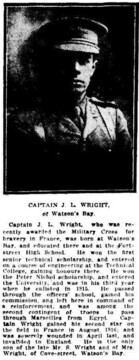Coming Soon.
WRIGHT, John Lawrence
Personal Details
| Service Number: | N73766 |
|---|---|
| Enlisted: | 8 May 1915, Sydney |
| Last Rank: | Captain |
| Last Unit: | Corps of Electrical and Mechanical Engineers |
| Born: | Watsons Bay, New South Wales, Australia, 31 December 1891 |
| Home Town: | Watsons Bay, Woollahra, New South Wales |
| Schooling: | Sydney University, New South Wales, Australia, |
| Occupation: | Engineering Student |
| Died: | Natural causes, North Sydney, New South Wales, Australia, 27 December 1950, aged 58 years |
| Cemetery: |
Northern Suburbs Memorial Gardens and Crematorium, NSW Cremated |
| Memorials: |
Service History
World War 1 Service
| 8 May 1915: | Enlisted AIF WW1, Second Lieutenant, 17th Infantry Battalion, Sydney | |
|---|---|---|
| 20 Jan 1916: | Involvement 17th Infantry Battalion, --- :embarkation_roll: roll_number: '12' embarkation_place: Sydney embarkation_ship: HMAT Runic embarkation_ship_number: A54 public_note: '' | |
| 20 Jan 1916: | Embarked 17th Infantry Battalion, HMAT Runic, Sydney | |
| 17 Aug 1916: | Promoted AIF WW1, Lieutenant, 17th Infantry Battalion | |
| 3 May 1917: | Wounded AIF WW1, Lieutenant, Noreuil, France, GSW abdomen (severe) | |
| 18 Jun 1917: | Honoured Military Cross, Bullecourt (Second), For conspicuous gallantry and absolute disregard for personal danger at Noreuil on morning of 3 May 1917 (incorrectly recorded as 15th), over ground continuously swept by machine gun and rifle fire, bringing back information (despite being severely wounded) that enable enemy attack on the flank to be smashed. | |
| 22 Jun 1917: | Promoted AIF WW1, Captain, 17th Infantry Battalion | |
| 7 Feb 1919: | Embarked AIF WW1, Captain, 17th Infantry Battalion, HT Lancashire, England for return to Australia - arriving Melbourne 24 March 1919. | |
| 22 Jun 1919: | Discharged AIF WW1, Captain, 17th Infantry Battalion |
World War 2 Service
| 3 Sep 1942: | Enlisted N73766, Australian Army Ordnance Corps, Captain | |
|---|---|---|
| 3 Sep 1942: | Enlisted N73766 | |
| 16 Sep 1944: | Discharged N73766, Corps of Electrical and Mechanical Engineers, Captain |
Personal Stories
Help us honour John Lawrence Wright's service by contributing information, stories, and images so that they can be preserved for future generations.
Add my story









